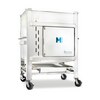OP03L Sigma-AldrichAnti-p53 (Ab-1) (Pantropic) Mouse mAb (PAb421)
This Anti-p53 (Ab-1) (Pantropic) Mouse mAb (PAb421) is validated for use in Frozen Sections, Gel Shift, Immunoblotting, IF, FC, IP for the detection of p53 (Ab-1) (Pantropic).
More>> This Anti-p53 (Ab-1) (Pantropic) Mouse mAb (PAb421) is validated for use in Frozen Sections, Gel Shift, Immunoblotting, IF, FC, IP for the detection of p53 (Ab-1) (Pantropic). Less<<Recommended Products
개요
| Replacement Information |
|---|
주요 사양표
| Species Reactivity | Host | Antibody Type |
|---|---|---|
| H, Mk, M, Rb, R | M | Monoclonal Antibody |
가격 및 재고여부
| 카탈로그 번호 | 재고 정보 | 패킹 | 포장 단위 | 가격(VAT 별도) | 수량 | |
|---|---|---|---|---|---|---|
| OP03L-100UGCN |
|
Plastic ampoule | 100 μg |
|
— |
| Description | |
|---|---|
| Overview | Recognizes the ~53 kDa mammalian wild-type and mutant p53 protein. Does not recognize phosphorylated p53. |
| Catalogue Number | OP03L |
| Brand Family | Calbiochem® |
| Product Information | |
|---|---|
| Form | Lyophilized |
| Formulation | Lyophilized from a volatile buffer, 100 µg BSA. |
| Negative control | Normal skin tissue or SK-OV-3 cells |
| Positive control | Breast carcinoma, A431 cells, or p53 standard (Cat. No. 506147) |
| Preservative | None |
| Quality Level | MQ100 |
| Physicochemical Information |
|---|
| Dimensions |
|---|
| Materials Information |
|---|
| Toxicological Information |
|---|
| Safety Information according to GHS |
|---|
| Safety Information |
|---|
| Product Usage Statements |
|---|
| Packaging Information |
|---|
| Transport Information |
|---|
| Supplemental Information |
|---|
| Specifications |
|---|
| Global Trade Item Number | |
|---|---|
| 카탈로그 번호 | GTIN |
| OP03L-100UGCN | 04055977209594 |
Documentation
Anti-p53 (Ab-1) (Pantropic) Mouse mAb (PAb421) MSDS
| 타이틀 |
|---|
Anti-p53 (Ab-1) (Pantropic) Mouse mAb (PAb421) Certificates of Analysis
| Title | Lot Number |
|---|---|
| OP03L |
References
| 참고문헌 보기 |
|---|
| El-Deiry, W.S., et al. 1994. Cancer Res. 54, 1169. Greenblatt, M.S., et al. 1994. Cancer Res. 54, 4855. Legros, Y., et al. 1994. Oncogene 9, 2071. Barak, Y., et al. 1993. EMBO J. 12, 461. Kuerbitz, S.J. 1992. Proc. Natl. Acad. Sci. USA 89, 7491. Kastan, M.B., et al. 1992. Cell 71, 587. Lane, D.P. 1992. Nature 358, 15. Kastan, M.B., et al. 1991. Cancer Res. 51 6304. Crawford, L. and Harlow, E. 1982. J. Virol. 41, 709. Harlow, E., et al. 1981. J. Virol. 39 861. |
Brochure
| Title |
|---|
| Interactive Pathway Calendar |












